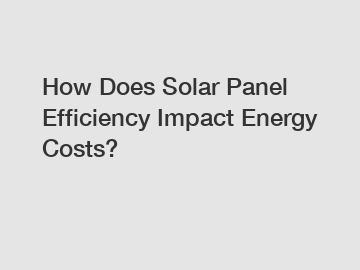How Do Solar Panels Impact Energy Costs?
Sep. 27, 2024
Understanding Energy Costs
Energy costs are an essential aspect of modern living, affecting both personal finances and business operations. Solar panels have emerged as a viable alternative to traditional energy sources, potentially transforming how we approach energy expenses. To grasp their impact, we need to delve into several key factors.
Initial Investment and Installation
The first step in understanding how solar panels affect energy costs is to consider the initial investment and installation. Homeowners or businesses must purchase solar panels, which can range from a few thousand to tens of thousands of dollars depending on size and quality. This initial cost can be daunting, but it's important to remember that many governments offer tax incentives or rebates to offset expenses. Financing options, like loans or leases, can also make solar energy more accessible.
Energy Bill Reduction
One of the most direct impacts of solar panels on energy costs is the reduction of monthly energy bills. By generating their own electricity, users can decrease their reliance on the grid, leading to significant savings. As solar technology improves, the efficiency of panels continues to rise, allowing for more energy production with less investment. Some households may even reach a point of net-zero energy consumption, where their electricity costs become negligible.
Return on Investment
While the upfront costs can be high, the return on investment (ROI) for solar panels can be quite favorable. Many users see a payback period of 5 to 7 years, depending on their location, energy consumption, and incentives. After that, they can enjoy years of reduced energy costs and potential energy credits from selling excess power back to the grid. In areas with increasing electricity costs, the savings can accumulate substantially over time.
Energy Independence
Solar panels contribute to energy independence, reducing reliance on fossil fuels and grid-supplied electricity. This shift not only leads to potential cost savings but also stabilizes energy expenses against fluctuating energy prices. As more individuals and businesses adopt solar technology, communities can benefit from decreased demand for conventional energy sources, leading to potentially lower overall energy costs for everyone.
Explore more:How Do Solar Panels Export Work?
Long-Term Cost Considerations
The effect of all kinds of packing element sealing ring
What Is Ductile Iron Pipe Used for?
Differentiating industrial hoses: Tips for buyers?
Are R9 Braids the Ultimate Protective Style?
Are OEM wire spiral hydraulic hoses better?
Mastering the Art of Wire Spiral Hose
Beyond immediate savings, solar panels typically require minimal maintenance and often come with warranties lasting 20 years or more. This long-term durability means fewer unexpected costs compared to traditional energy systems. Furthermore, as society gradually shifts toward renewable energy, the relative costs of solar versus non-renewable sources could become even more beneficial for solar consumers.
Environmental and Social Impact
While the focus is often on financial implications, the environmental impact of solar panels cannot be overlooked. Reduced greenhouse gas emissions and a lower carbon footprint appeal to many consumers. This growing emphasis on sustainability can also influence energy costs indirectly by shaping policies and regulations that promote cleaner energy sources.
Conclusion
In summary, solar panels significantly impact energy costs through initial investment, reduced energy bills, ROI, and energy independence. As the technology advances and public sentiment shifts toward renewable resources, solar energy is set to play a crucial role in reshaping future energy economics. Understanding these aspects can empower consumers and businesses to make informed decisions about adopting solar energy solutions.
For more information, please visit steel buoys export, UHMWPE Pipes customize, buoyandpipe.com.
Explore more:What are hydraulic hoses made of? Are traditional materials still the best choice?
How Chinese Hydraulic Fittings Improve Industrial Systems?
How to choose SAE 100 R1 hose?
Unraveling the Benefits of EN 856 4SH
How to Choose How Many AC Lines Are in a Car
4 Tips to Select a Textile Braid on Sale
OEM Wire Spiral High Pressure Hydraulic Hose: Steel vs Rubber
40
0
0
Related Articles





Comments
All Comments (0)